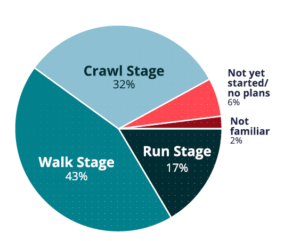Whether or not you’re running workload in the public cloud, the lure to develop in the modern cloud-native fashion is undeniably strong. After all, the benefits of running containerized microservices in a serverless fashion are well-known and myriad: improved portability, higher scalability, faster deployments, better flexibility, and superior maintainability. Unfortunately, a pair of new reports suggests you add another attribute to going cloud-native: higher costs.
When it comes to reasons to move to the public cloud, “saving money” has long since been replaced with “increased agility.” Like the systems vendors they are in the process of displacing, AWS, Microsoft Azure, and Google Cloud have figured out how to maximize their customers’ infrastructure spend, with a little (actually a lot of) help from the unalterable economics of data gravity.
Regardless of where the workloads run, the promised cost savings of adopting cloud-native technologies and techniques do not seem to be panning out, at least in the short term, according to a pair of reports issued this week.
For its second annual State of Kubernetes report, Pepperdata queried 800 cloud decision-makers and IT pros about the state of their containerized environments. It found that Kubernetes users are running an average of six to 10 clusters each, and that the most popular applications for their Kubernetes clusters were data ingestion, cleansing, and analytics workloads, which 61% of the respondents run, followed by database (59%), Web serving (58%), and AI and machine learning ( 54%) workloads.
The report says 57% of respondents listed “significant or unexpected spend on compute, storage, networking infrastructure, or cloud-based IaaS” as their most pressing Kubernetes challenge. That was followed by a steep learning curve for employees to master Kubernetes across development, operations, and security (56%), limited support for stateful applications (52%), and a lack of visibility into Kubernetes spend leading to cost overruns (50%).
Companies are trying to rein in their cloud costs using FinOps techniques. However, these endevors are not mature at the moment, with 43% of the respondents in Pepperdata’s survey saying they’re in the “walk” stage of their FinOps journey (as defined and measured by the FinOps Foundation). The survey found 32% of respondents are in the “crawl” stage while just 17% are in the “run” stage.
“The survey confirms that Kubernetes has become the preferred choice for deploying workloads among agile enterprises,” Pepperdata CEO Ash Munshi states in a press release. “However, the speed and ease of deployment can result in unexpected infrastructure cost overruns. Respondents are increasingly turning to FinOps and cloud cost optimization tools to help them remediate the cost of operating in the cloud and optimize their Kubernetes clusters.”

Companies are just starting out with their FinOps tactics to reduce cloud spending, Pepperdata finds
The high cost of cloud-native development was tackled in another report this week by OutSystems, which provides a pre-built cloud-native platform hooked up to a low-code development environment.
Titled “Cloud-Native Development Report: The High Cost of Ownership,” the white paper tracks the journey of a hypothetical company as it embarks on a transition to cloud-native computing. The insurance company, Atom, has $3 billion in revenue and a $190 million IT budget. It also has a goal of using cloud-native technologies and techniques to create and run a Web portal and a mobile app that connects customers to its backend ERP and CRM systems (which aren’t being modernized).
While many of the technologies at the core of the cloud-native approach, such as Kubernetes, are free and open source, there are substantial costs incurred, predominantly around the infrastructure and the personnel. In particular, the costs of finding IT practitioners with experience in using and deploying cloud-native technologies was among the biggest hurdles identified by the report, which you can read here.
“Kubernetes…is extraordinarily complex, and experienced practitioners are scarce resources,” the report states. “Organizations that deploy it find they must dedicate significant resources to configure and run it properly.”
But K8s is just the start of the challenges, according to OutSystems. The prospective cloud-native adopter must also retrain their existing developers on microservices architectures; account for the network and security needs of cloud-native architectures; and retool all DevOps processes for the cloud-native approach. “All these challenges combine to exponentially increase complexity,” the white paper states. “And the inevitable byproduct of all those overlapping layers of complexity is cost.”
All told, the cost to build the portal and Web apps comes to $5.6 million and it takes 18 months. The infrastructure costs $2.7 million while the application development personnel costs amount to $2.9 million. The white paper didn’t come right out and say it, but left the reader with the impression that the cost outlays and development times would be significantly shorter using traditional technologies and techqniues.
Despite the benefits of going cloud-native, such as higher availability agility, scalability, elasticity, and easy geographic distribution, the costs and complexity are not trivial, and are the reason “why today few companies–beyond the Netflix and Ubers of the world–have fully embraced cloud-native computing,” OutSystems says.
“Cloud-native applications have the clear advantage over legacy software. There’s no debate that cloud-native applications respond to the market faster, offer better user experience and provide superior scalability and resilience,” OutSystems CTO Patrick Jean says in a press release. “But this shift also represents an overhaul of the traditional software development process–one that most companies are not equipped to handle.”
Related Items:
Kubernetes Adoption Widespread for Big Data, But Monitoring and Tuning Are Issues, Survey Finds
Containerized Storage with Kubernetes Goes Mainstream in the Large Enterprise
The post The High Costs of Going Cloud-Native appeared first on Datanami.



0 Commentaires